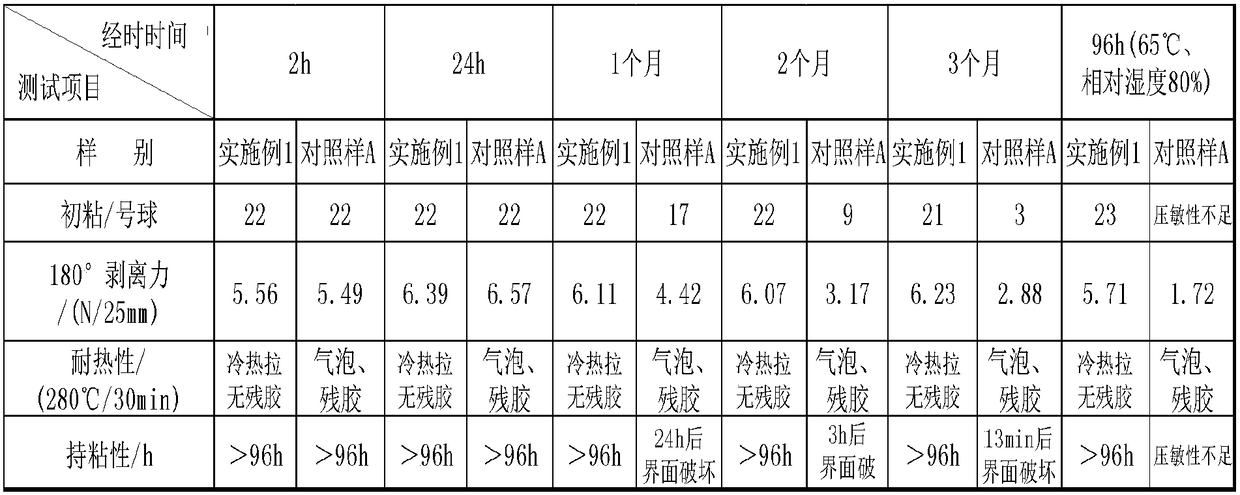A method for improving the stability of silicone pressure-sensitive adhesives for protective films
A silicone pressure-sensitive adhesive, stability technology, applied in the direction of adhesives, etc., can solve problems such as viscosity and other performance changes gradually, cannot meet the use requirements, and use performance is unstable, so as to inhibit the occurrence of reverse reactions and improve the use performance. Good, the effect of improving stability
- Summary
- Abstract
- Description
- Claims
- Application Information
AI Technical Summary
Problems solved by technology
Method used
Image
Examples
Embodiment 1
[0031] Step 1) polycondensation reaction
[0032] Put 100Kg of toluene and 200Kg of xylene into the reactor, add 500g of diethylamine, stir evenly, then add 200Kg of hydroxyl-terminated polydimethylsiloxane with a viscosity of about 8000mPa.s and 300Kg of nM / nQ MQ resin with Mn of 0.75 about 5000g / mol, Mw about 18000g / mol and hydroxyl content of about 3%, continued to stir for 30min under the protection of nitrogen, then raised the temperature to about 135°C and kept the reflux for stable reaction for about 210min, during the reaction The generated water is continuously discharged through the Dean-Stark trap or U-shaped pipe trap;
[0033] Step 2) Remove water
[0034] The temperature in the reactor is lowered to room temperature, and the composition of 1.5Kg is added to the reactor under stirring. Water agent A", continue to stir for more than 30 minutes;
[0035] Step 3) Removal of Residual Hydroxyl
[0036]Under nitrogen protection and stirring state, the reaction tempe...
Embodiment 2
[0048] Step 1) polycondensation reaction
[0049] Put 100Kg of toluene and 200Kg of xylene into the reactor, add 500g of triethylamine, stir evenly, then add 200Kg of hydroxyl-terminated polydimethylsiloxane with a viscosity of about 7000mPa.s and 300Kg of nM / nQ MQ resin with Mn of 0.80 about 5000g / mol, Mw about 18000g / mol and hydroxyl content of about 3% was stirred for 30min under nitrogen protection, then heated to about 135°C and kept under reflux for a stable reaction of about 210min. During the reaction The generated water is continuously discharged through the Dean-Stark trap or U-shaped pipe trap;
[0050] Step 2) Remove water
[0051] Keep the temperature in the reactor at room temperature, add 1.0Kg of water remover ALT-201 into the reactor under stirring, and continue stirring for more than 30 minutes;
[0052] Step 3) Removal of Residual Hydroxyl
[0053] Under nitrogen protection and stirring state, the reaction temperature was maintained at 50°C, 5000g of hexa...
Embodiment 3
[0064] Embodiment 3 (improves the stability of finished product silicone pressure-sensitive adhesive)
[0065] Step 1) Remove water
[0066] Put 1000Kg of domestic finished silicone pressure-sensitive adhesive in the reaction kettle, add 1.0Kg of water remover ALT-202 into the reaction kettle while stirring, and continue stirring for more than 30 minutes;
[0067] Step 2) remove residual hydroxyl
[0068] Under the protection of nitrogen and stirring, the reaction temperature was reduced to 50°C, and 5000g of tetramethyldivinyldisilazane was added to stir the reaction for 1 hour, then the temperature was raised to 90°C, and the flow rate of nitrogen was increased to drive off the reaction generated NH3 cannot detect the ammonia component until the outlet of the condenser; when the ammonia removal is completed, keep the adhesive reaction system at about 70°C, and start to deactivate the polycondensation catalyst;
[0069] Step 3) Catalyst deactivation treatment
[0070] Keep...
PUM
| Property | Measurement | Unit |
|---|---|---|
| viscosity | aaaaa | aaaaa |
| viscosity | aaaaa | aaaaa |
Abstract
Description
Claims
Application Information
 Login to View More
Login to View More - R&D Engineer
- R&D Manager
- IP Professional
- Industry Leading Data Capabilities
- Powerful AI technology
- Patent DNA Extraction
Browse by: Latest US Patents, China's latest patents, Technical Efficacy Thesaurus, Application Domain, Technology Topic, Popular Technical Reports.
© 2024 PatSnap. All rights reserved.Legal|Privacy policy|Modern Slavery Act Transparency Statement|Sitemap|About US| Contact US: help@patsnap.com










